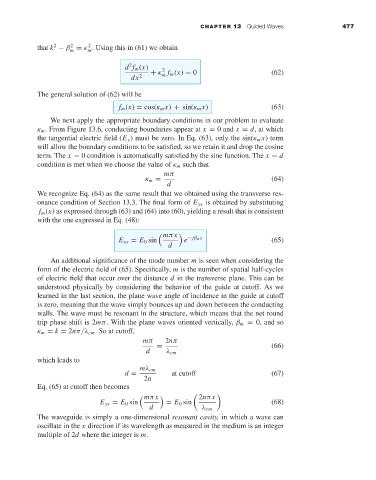Page 495 - Engineering Electromagnetics, 8th Edition
P. 495
CHAPTER 13 Guided Waves 477
2
2
2
that k − β = κ . Using this in (61) we obtain
m
m
2
d f m (x) + κ f m (x) = 0 (62)
2
dx 2 m
The general solution of (62) will be
f m (x) = cos(κ m x) + sin(κ m x) (63)
We next apply the appropriate boundary conditions in our problem to evaluate
κ m . From Figure 13.6, conducting boundaries appear at x = 0 and x = d,at which
the tangential electric field (E y ) must be zero. In Eq. (63), only the sin(κ m x) term
will allow the boundary conditions to be satisfied, so we retain it and drop the cosine
term. The x = 0 condition is automatically satisfied by the sine function. The x = d
condition is met when we choose the value of κ m such that
mπ
κ m = (64)
d
We recognize Eq. (64) as the same result that we obtained using the transverse res-
onance condition of Section 13.3. The final form of E ys is obtained by substituting
f m (x)asexpressed through (63) and (64) into (60), yielding a result that is consistent
with the one expressed in Eq. (48):
mπx
E ys = E 0 sin e − jβ m z (65)
d
An additional significance of the mode number m is seen when considering the
form of the electric field of (65). Specifically, m is the number of spatial half-cycles
of electric field that occur over the distance d in the transverse plane. This can be
understood physically by considering the behavior of the guide at cutoff. As we
learned in the last section, the plane wave angle of incidence in the guide at cutoff
is zero, meaning that the wave simply bounces up and down between the conducting
walls. The wave must be resonant in the structure, which means that the net round
trip phase shift is 2mπ.With the plane waves oriented vertically, β m = 0, and so
κ m = k = 2nπ/λ cm .Soat cutoff,
mπ 2nπ (66)
d = λ cm
which leads to
mλ cm
d = at cutoff (67)
2n
Eq. (65) at cutoff then becomes
mπx 2nπx
E ys = E 0 sin = E 0 sin (68)
d λ cm
The waveguide is simply a one-dimensional resonant cavity, in which a wave can
oscillate in the x direction if its wavelength as measured in the medium is an integer
multiple of 2d where the integer is m.

